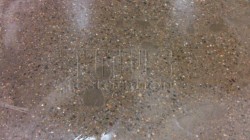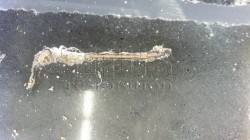The following specifications are recommended for concrete placement contractors, general contractors, and architects when writing and following specs for concrete that is to be polished in new construction:
- Plastic trowel blades should be used on power trowel machines to prevent burning the concrete.
- It is preferable to wet cure concrete slabs that are intended to be polished rather than using curing compounds. If this is not possible you can contact us to learn about products specifically developed for these cases (our lithium based curing compound is one of the best solutions when there is not time to wet cure).
- Another important aspect that must be considered are the FF and FL numbers of the placed concrete.
- Wet grinding creates concrete slurry. This slurry is generated prior to us adding chemicals to the floor, therefore, it is only the lime from the surface of the concrete contained in the slurry. It can be easily be disposed of prior to paving by rinsing out a door on the “crush and run” gravel paving base or subsoil of the parking lot.
- Resin based curing compounds are incompatible with grinding concrete, either wet or dry. These compounds form membranes (films) that can melt to close the diamond matrix/profile and prevent the diamond abrasives from cutting properly, possibly creating the need for a deeper (more expensive) grind. If all curing compound is not removed, the silicate densifier will not penetrate into the concrete to harden the free calcium in the concrete (which is at the core of a harder wear surface and longer lasting finish).
- KEEP THE FOOT PRINTS OUT OF THE CONCRETE! When a project is large enough, use a ride on trowel to finish the concrete and do not walk in the wet concrete. Again, PLASTIC TROWEL BLADES ARE PREFERABLE so as not burn the concrete. If finishing with a walk behind power trowel, work your way off the slab and evenly trowel all surfaces. We often find “fossil” foot prints once the concrete grinding process has begun. The finished slab may look perfect as long as there is a uniform layer of lime on the surface, but footprints begin to show up when that lime is removed. These are areas where the foot print or actual tread print of a boot may be visible. This is a result of the sand or aggregate being pushed deeper into the concrete by the foot print or boot tread and the deeper prints were floated in with just lime. When the floor is ground and polished, the entire floor may have a perfect sand or aggregate finish (except for those footprints of lime paste).
- If coloring concrete, we believe a thorough power trowel finish is preferable. Trowel marks and the swirls in the concrete make for a more variegated looking floor. Multiple passes of the power trowel are preferred for this finish (without burning the concrete) as they will float the fine aggregate to the top and push the heavier aggregate deeper into the concrete.
- Salt and pepper finishes (exposed sand) have more even sand exposure on flatter floors (F(f) 50 or higher. On wavy floors, the high spots may be exposed aggregate with the low spots more having more concentrate of concrete cream. It may also be necessary to cut to sand when removing mastic on existing floors (although the “ghosting” of the tiles may remain after grinding and polishing). We believes a medium power trowel finish is preferable. A wavy floor F(f) 30 or less may show aggregate along with the salt and pepper (sand). Power trowel this finish as normal without burning the concrete.
- Footprints
- Foreign Material
Exposed aggregate concrete finishes are the most difficult to perform. The success of this finish depends on even aggregate exposure in the concrete. Aggregate that is shake applied to the wet concrete provides a more even distribution. When exposing aggregate in poured concrete, we have found that it is best to cut to the aggregate before the concrete is fully cured (but not too early). We recommend performing the first cut between 7 and 14 days after the pour. Performing the first cut sooner may jar the aggregate causing micro fractures between the aggregate and the lime and then these fracture will grow from aggregate to aggregate, eventually micro fracturing the entire surface. We believe a light power trowel finish is preferable (one pass and get off the floor). As always, a floor flatness of F(f)50 is preferable. Using larger equipment can expose aggregate faster and level wavy floors.
Other Relevant Topics:
- What is Polished Concrete
- Benefits of Polished Concrete
- How to Polish Concrete
- Polished Concrete Maintenance
- Expectations and Possibilities of Polished Concrete
- Tips for the GC
- Polished Concrete Cost


